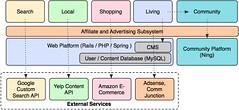Earlier this yaer, Joe Hewitt released a great library named iUI for easily developing iPhone-friendly mobile web applications using a basic set of HTML tags. Here’s a brief rundown of what it does:
* Create Navigational Menus and iPhone interfaces from standard HTML
* Use or knowledge of JavaScript is not required to create basic iPhone pages
* Ability to handle phone orientation changes
* Provide a more “iPhone-like” experience to Web apps (on or off the iPhone)
The good news is that since the Android platform uses the same WebKit browser, the iUI library works automagically with devices such as the T-Mobile G1. I had assume this, but to see that it basically works perfectly without changes, is great news. The only issue is that iUI obviously mirrors the user navigation elements and general interaction model of the iPhone native user experience. The iPhone model is highly usable and easy for most users to pick up, so I don’t think that is an issue, especially with the general lack of specific set of user interface guidelines for Android.
So, if you are looking for a quick way to build a usable, friendly, attractive web application that will work on iPhone AND Android, for now at least, iUI is your answer.
Here are some screenshots of the mobile site I developed earlier this year for Globalgrind.com. You can try it yourself by pointing your mobile device (it supports blackberry, wap, sidekick, etc as well) at: http://m.globalgrind.com or texting “ggrind” to 41411





